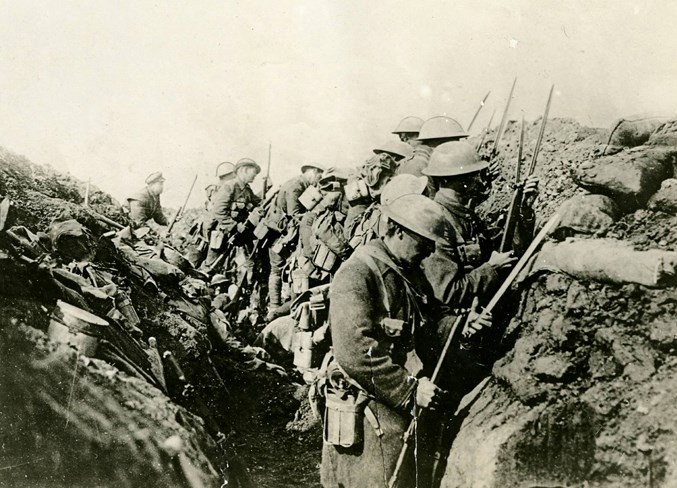This month commemorates the 100th anniversary of the end of the Great War, a war that was so significant and statistically bewildering that it became popularized as the “War that will End Wars.”
It is estimated 65 million men and women from 30 countries took part in the war with an estimated nine million combatant deaths, seven million collateral civilian deaths, and a further 23 million wounded, making this one of the deadliest conflicts in history. About 66,000 Canadians and 1,300 Newfoundlanders never returned home – many of those who did return suffered traumatic mental and physical disabilities.
The Great War began in 1914, lasted for four years, and ended (unofficially) on the 11th hour on the 11th day of the 11th month through the signing of an Armistice Agreement between the Allies and Germany in a railway carriage in Compiegne, France. A formal surrender treaty, however, did not take place until June 28, 1919 when the Treaty of Versailles was signed.
The first efforts to recognize the impact of the Great War began very soon after hostilities ended, a legacy that would continue over many years and continues today a century later.
King George V officially instituted Armistice Day in 1919 in commemoration of the first anniversary of the end of the war. Over time this event evolved to become known differently, such as Remembrance Day, Poppy Day, Veterans Day (in the U.S.) or Anzac Day (Australia and New Zealand). However, the significance, and the timing of the two-minute silence observed each year on Nov. 11 reflects the occasion of the end of the Great War.
The impact of the Great War was so great it led to many countries erecting memorials to symbolize and honour the sacrifice made by the many. In my home city of Coventry, England, a 90-foot-tall white Portland Stone memorial was constructed in 1921 as a tribute to those from the city who lost their lives in the Great War. The surrounding park has 800 trees, each with a stone plinth and metal placard at the base, and dedicated with the name of a lost serviceman. And today this Act of Remembrance continues with the recent addition of a new tree planted in dedication to a local soldier lost in the Afghanistan conflict.
The Innisfail cenotaph was unveiled in 1935. The Canadian National War Memorial in Ottawa was officially unveiled in 1939 and is themed as the Great Response of Canada by its designer Vernon March. The idea, he said, was "to perpetuate the people of Canada who went overseas to the Great War, and to represent them, as a record for future generations."
The work of the Great War poets provided recorded first-hand accounts of their experiences of the war. Most of the poems were published after the war ended. The poems, originally patriotic in fervour, “how sweet and honourable it is to die for one’s country” (Wilfred Owen – Dulce et Decorum est) had however taken on a more sombre mood as the war continued. “They shall not grow old as we that are left grow old” (Laurence Binyon). Finally, in reflection of the growing numbers of dead, words of Remembrance prevailed, “in Flanders fields the poppies grow” (John McCrae).
The numerous post-war cemetery monuments, graves and memorials all required appropriate words and phrases for their inscriptions. Today we all know recognizable phrases borne out of the need to remember the Great War dead. “Their Name Liveth for Evermore,” (King James Bible, Ecclesiasticus, chapter 44, verse 14), “Lest We Forget” (Rudyard Kipling’s recessional), “We Will Remember Them” (Laurence Binyon’s poem, For The Fallen).
It is the red poppy, however, that remains the best-known symbol of Remembrance inspired by Canadian war poet John McCrae and American YWCA volunteer Miona Michael, who in her 1918 poem titled, “We Shall Keep the Faith” vowed to wear a red poppy as a symbol of Remembrance. In 1921 the Royal Canadian Legion adopted the poppy as its official symbol of Remembrance.
This year, 100 years on, special commemorative events are scheduled to take place worldwide to mark the centenary of the Great War Armistice. One such event planned at the St. Symphorien Cemetery near Mons in Belgium is significant in that it is the place where the war began in 1914, and it is also the place of the first and last casualties of the Great War.
Pte. George Lawrence Price, of Falmouth, N.S., was the last Allied soldier to be killed during the war. He was conscripted in 1917 in Moose Jaw, Sask., and served in the Canadian Expeditionary Force. His grave is maintained by the Commonwealth War Graves Commission which today maintains the graves and memorials of 1.7 million servicemen and -women at 23,000 locations in 153 countries.
And so, the Great War is remembered even to this day – but its enduring legacy did not end all wars. It was a triumph (like most wars) for advances in science and technology and many other improvements, such as in medicine, sanitation, transportation, psychiatry, and national defence budgets for future military engagements.
The Great War changed the course of history in Europe forever -- it destroyed empires (Austria- Hungary), led to revolution (Russia), removed monarchies (Kaiser Wilhelm II) and ultimately sowed the seeds for an even more large-scale war 20 years later.
Today there are no survivors of the Great War. They are a past generation. Many of us however have some form of connection with that generation; those who experienced directly or indirectly the reality and brutality of the Great War. We, as the generations of their descendants, must continue together to preserve the memory of something that we cannot remember first hand but which we must never forget. At this special time of commemoration please wear a red poppy.
Arno Glover is a member of the Innisfail Royal Canadian Legion.



